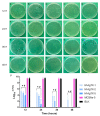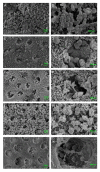Mesoporous Calcium-Silicate Nanoparticles Loaded with Low-Dose Triton-100+Ag+ to Achieve Both Enhanced Antibacterial Properties and Low Cytotoxicity for Dentin Disinfection of Human Teeth
- PMID: 34575596
- PMCID: PMC8464954
- DOI: 10.3390/pharmaceutics13091518
Mesoporous Calcium-Silicate Nanoparticles Loaded with Low-Dose Triton-100+Ag+ to Achieve Both Enhanced Antibacterial Properties and Low Cytotoxicity for Dentin Disinfection of Human Teeth
Abstract
Mesoporous calcium-silicate nanoparticles (MCSNs) are excellent biomaterials for controlled drug delivery and mineralization induction. In this study, MCSNs were loaded with low-dose silver ion (Ag+) and Triton X-100 (TX-100) as the M-AgTX to achieve both enhanced antibacterial properties and low cytotoxicity for dentin disinfection. The physicochemical property, biocompatibility, infiltration ability into dentinal tubules, anti-bacterial ability against both planktonic Enterococcusfaecalis (E. faecalis) and its biofilm on dentin, effects on dentin microhardness and in vitro mineralization property were systematically investigated. Results confirmed that the MCSNs and M-AgTX nanoparticles showed typical morphology of mesoporous materials and exhibited sustained release of chemicals with an alkaline pH value over time. M-AgTX also exhibited excellent biocompatibility on MC3T3-E1 cells and could eliminate 100% planktonic E. faecalis after 48-h treatment. On dentin slices, it could enter dentinal tubules by ultrasonic activation and inhibit the growth of E. faecalis on dentin. M-AgTX could completely inactive 28-day E. faecalis biofilm. TEM confirmed the destruction of cell membrane integrity and Ag+ infiltration into bacteria by M-AgTX. Besides, dentin slices medicated with M-AgTX nanoparticles displayed an increased microhardness. After being immersed in SBF for 7 days, apatite crystals could be observed on the surface of the material tablets. M-AgTX could be developed into a new multifunctional intra-canal medication or bone defect filling material for infected bone defects due to its sustained release profile, low cytotoxicity, infiltration ability, enhanced anti-bacterial and mineralization features.
Keywords: Enterococcus faecalis; Triton X-100; mesoporous; nanoparticle; root canal disinfection; silver.
Conflict of interest statement
The authors declare no conflict of interest.
Figures













Similar articles
-
Effects of adsorbed and templated nanosilver in mesoporous calcium-silicate nanoparticles on inhibition of bacteria colonization of dentin.Int J Nanomedicine. 2014 Nov 12;9:5217-30. doi: 10.2147/IJN.S73144. eCollection 2014. Int J Nanomedicine. 2014. PMID: 25419127 Free PMC article.
-
Calcium-silicate mesoporous nanoparticles loaded with chlorhexidine for both anti- Enterococcus faecalis and mineralization properties.J Nanobiotechnology. 2016 Oct 21;14(1):72. doi: 10.1186/s12951-016-0224-7. J Nanobiotechnology. 2016. PMID: 27769275 Free PMC article.
-
Ca-Si mesoporous nanoparticles with the optimal Ag-Zn ratio inhibit the Enterococcus faecalis infection of teeth through dentinal tubule infiltration: an in vitro and in vivo study.J Mater Chem B. 2021 Mar 11;9(9):2200-2211. doi: 10.1039/d0tb02704a. J Mater Chem B. 2021. PMID: 33447835
-
Substantivity of Ag-Ca-Si mesoporous nanoparticles on dentin and its ability to inhibit Enterococcus faecalis.J Mater Sci Mater Med. 2016 Jan;27(1):16. doi: 10.1007/s10856-015-5633-x. Epub 2015 Dec 16. J Mater Sci Mater Med. 2016. PMID: 26676862
-
Silver Nanoparticles and Their Therapeutic Applications in Endodontics: A Narrative Review.Pharmaceutics. 2023 Feb 21;15(3):715. doi: 10.3390/pharmaceutics15030715. Pharmaceutics. 2023. PMID: 36986576 Free PMC article. Review.
Cited by
-
Biomimetic Scaffolds of Calcium-Based Materials for Bone Regeneration.Biomimetics (Basel). 2024 Aug 24;9(9):511. doi: 10.3390/biomimetics9090511. Biomimetics (Basel). 2024. PMID: 39329533 Free PMC article. Review.
-
Silver Nanoparticles as an Intracanal Medicament: A Scoping Review.ScientificWorldJournal. 2023 Sep 11;2023:9451685. doi: 10.1155/2023/9451685. eCollection 2023. ScientificWorldJournal. 2023. PMID: 37727615 Free PMC article.
-
Antimicrobial Effects of Formulations of Various Nanoparticles and Calcium Hydroxide as Intra-canal Medications Against Enterococcus faecalis: A Systematic Review.Cureus. 2024 Sep 28;16(9):e70382. doi: 10.7759/cureus.70382. eCollection 2024 Sep. Cureus. 2024. PMID: 39469360 Free PMC article. Review.
-
When oral health affects overall health: biofilms, dental infections, and emerging antimicrobial strategies.Infection. 2025 Apr 22. doi: 10.1007/s15010-025-02533-9. Online ahead of print. Infection. 2025. PMID: 40261483 Review.
-
Enhancing gutta-percha with silver mesoporous calcium silicate nanoparticles for advanced endodontic applications.PLoS One. 2025 Aug 12;20(8):e0329435. doi: 10.1371/journal.pone.0329435. eCollection 2025. PLoS One. 2025. PMID: 40794734 Free PMC article.
References
-
- Carr G.B., Schwartz R.S., Schaudinn C., Gorur A., Costerton J.W. Ultrastructural examination of failed molar retreatment with secondary apical periodontitis: An examination of endodontic biofilms in an endodontic retreatment failure. J. Endod. 2009;35:1303–1309. doi: 10.1016/j.joen.2009.05.035. - DOI - PubMed
Grants and funding
LinkOut - more resources
Full Text Sources

